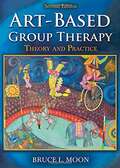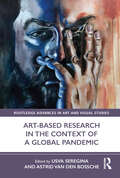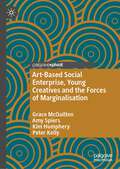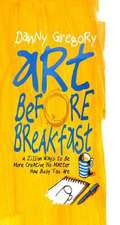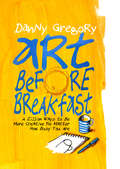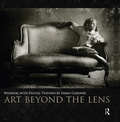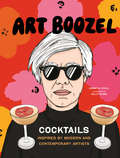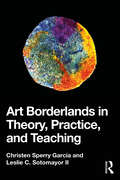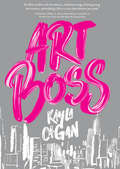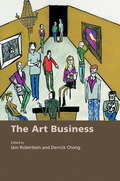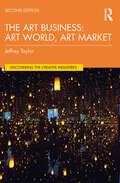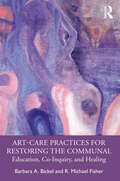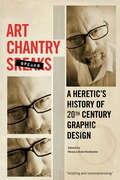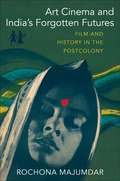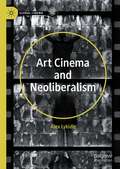- Table View
- List View
Art-based Group Therapy: Theory And Practice
by Bruce L. MoonIn this second edition Moon provides essential principles regarding art-based therapy groups. The book is intended for art therapy students and practitioners, offering philosophic and practical information related to the use of art in a host of group therapy contexts.
Art-based Group Therapy: Theory and Practice
by Bruce L. MoonPerhaps more than ever before, today's art therapists are being encouraged to apply their knowledge base to the development of strategies for community building, and art-based approaches to preventing and treating emotional problems. In many settings, individual counseling or psychotherapy is no longer financially feasible. Art-based group therapy allows art therapists to work with many more clients than would be possible in individual sessions. Moreover, art-based group process also has unique qualities that can often serve as the treatment of choice for many clients.
Art-Based Research
by Shaun McniffArt therapy and all of the other creative arts therapies have promoted themselves as ways of expressing what cannot be conveyed in conventional language. Why is it that creative arts therapists fail to apply this line of thinking to research? In this exciting and innovative book, Shaun McNiff, one of the field's pioneering educators and authors, breaks new ground in defining and inspiring art-based research. He illustrates how practitioner-researchers can become involved in art-based inquiries during their educational studies and throughout their careers, and shows how new types of research can be created that resonate with the artistic process. Clearly and cogently expressed, the theoretical arguments are illustrated by numerous case examples, and the final part of the book provides a wealth of ideas and thought provoking questions for research. This challenging book will prove invaluable to creative art therapy educators, students, and clinicians who wish to approach artistic inquiry as a way of conducting research. It will also find a receptive audience within the larger research community where there is a rising commitment to expanding the theory and practice of research. Integrating artistic and scientific procedures in many novel ways, this book offers fresh and productive visions of what research can be.
Art-Based Research in the Context of a Global Pandemic (Routledge Advances in Art and Visual Studies)
by Usva Seregina Van den Bossche, AstridLiving through the Covid-19 global pandemic has changed the way that we experience our lives, the way that we relate to one-another, and the way that we engage with the world. Focusing contextually on the initial lockdowns of the pandemic in 2020, this book proposes that art-based research has a central, illuminative role to play in our understanding of unfolding crises. The changes brought on by the global event may not be readily accessible or expressible through traditional academic research. Art-based research offers the opportunity to explore, document, and reflect on the emerging and often ineffable qualities of transformed lives by drawing on emotional, bodily, and interactive aspects of experience. Such an approach allows for meaning-making that makes room for reflexive, interpersonal, and dialogical engagement. The contributions aim to capture and explore lived experiences of the pandemic, as well as begin a discussion about how meaning-making is changing through and beyond the pandemic. This book further explores how the nature and practice of art-based research in itself has been challenged and transformed. The book will be of interest to scholars working in art education, art psychotherapy, consumer research, visual studies, cultural studies, and sociology.
Art-Based Social Enterprise, Young Creatives and the Forces of Marginalisation
by Grace McQuilten Amy Spiers Kim Humphery Peter KellyThis book analyses the challenges and opportunities faced by art-based social enterprises (ASEs) engaging young creatives in education and training and supporting their pathways to the creative industries. In doing so, it addresses the complex intersecting issues of marginality and entrepreneurship, particularly in relation to young creatives from socially, economically and culturally diverse backgrounds. Drawing on extensive fieldwork and interviews with twelve key organisations, and three in-depth case studies in Australia, the book offers a detailed analysis of using enterprise to engage with the structural challenges of marginality. The book explores the local and global contexts through which art-based social enterprises (ASEs) operate and within which they attempt – often successfully – to improve access to education and work for emerging creatives. It also attends to the findings generated through engaging with the lived experiences of the staff and young creatives involved in our ASE case studies, in order to understand both the challenges and impacts of the ASE model on young people’s education, training, and employment pathways. The book focuses on three broad themes; precarious youth and digital futures, material practice and sustainable economies, and cultural citizenship in the urban fringe. In exploring these themes, the book contributes to debates about the limits, possibilities and challenges that attach to, and emerge from, an ASE model and highlights the ways in which these models can contribute to young people’s well-being, engagement, education and training, and work pathways. More broadly, it examines the possibilities of art as a means of social and cultural engagement. In the context of the precarious future of the creative industries, this book emphasise the ways in which young artists are building alternative economic and cultural models that support both individual pathways and collective change. This book will move the field forward with a critical lens that engages closely with experience and the lived realities of juggling multiple priorities of social, economic and artistic goals.
Art-Based Supervision: Cultivating Therapeutic Insight Through Imagery
by Barbara J. FishArt-Based Supervision is a unique text for graduate supervision classes and seminars as well as a resource for post-graduate supervisors and practitioners. It offers a new view of supervision, one that incorporates both images and words as tools to investigate and communicate the interactions that occur in therapy and in the systems in which clinicians work. The fundamental principles of supervision provided in the book are useful for anyone interested in exploring the use of images to support reflection, understanding, and empathy in their work. Full-color images further enrich the narrative. In addition to supervision courses, Art-based Supervision may be used for introductory art therapy, psychology, social work, and counseling courses for readers interested in a broad range of intimate examples of the challenges of therapeutic work and the use of response art to grasp nuanced communication.
Art & Beauty
by Maurice de WulfThis work attempts to establish a philosophy of art that is both intellectual and objective. At first sight it may appear that these goals are at variance with contemporary ideas. On closer examination, however, the reader will see that the tendency is in the opposite direction, a closer approach to present-day thought rather than a departure from it. To admit that there exists a world other than that of our subjective states is to subscribe to an interpretation more in keeping with the real, and thus also with artistic reality. The intellectual and objective philosophy to which this book appeals in order to interpret the beauty of art will not be an intrusion, if it guards against all exclusiveness and does not itself compromise that which gives it its value.
Art Before Breakfast
by Danny GregoryPacked with the signature can-do attitude that makes beloved artist Danny Gregory a creativity guru to thousands across the globe, this unique guide serves up a hearty helping of inspiration. For aspiring artists who want to draw and paint but just can't seem to find time in the day, Gregory offers 5- to 10-minute exercises for every skill level that fit into any schedule--whether on a plane, in a meeting, or at the breakfast table--along with practical instruction on techniques and materials, plus strategies for making work that's exciting, unintimidating, and fulfilling. Filled with Gregory's encouraging words and motivating illustrations, Art Before Breakfast teaches readers how to develop a creative habit and lead a richer life through making art.
Art Before Breakfast: A Zillion Ways to be More Creative No Matter How Busy You Are
by Danny GregoryPacked with the signature can-do attitude that makes beloved artist Danny Gregory a creativity guru to thousands across the globe, this unique guide serves up a hearty helping of inspiration. For aspiring artists who want to draw and paint but just can't seem to find time in the day, Gregory offers 5– to 10–minute exercises for every skill level that fit into any schedule—whether on a plane, in a meeting, or at the breakfast table—along with practical instruction on techniques and materials, plus strategies for making work that's exciting, unintimidating, and fulfilling. Filled with Gregory's encouraging words and motivating illustrations, Art Before Breakfast teaches readers how to develop a creative habit and lead a richer life through making art.
Art before the Law
by Ruth RonenEver since Plato expelled the poets from his ideal state, the ethics of art has had to confront philosophy's denial of art's morality. In Art before the Law, Ruth Ronen proposes a new outlook on the ethics of art by arguing that art insists on this tradition of denial, affirming its singular ethics through negativity.Ronen treats the mechanism of negation as the basis for the relationship between art and ethics. She shows how, through moves of denial, resistance, and denouncement, art exploits its negative relation to morality. While deception, fiction, and transgression allegedly locate art outside morality and ethics, Ronen argues they enable art to reveal the significance of the moral law, its origins, and the idea of the good. By employing the thought of Freud and Lacan, Ronen reconsiders the aesthetic tradition from Plato through Kant and later philosophers of art in order to establish an ethics of art. An interdisciplinary study, Art before the Law is sure to be of interest both to academic philosophers and to those interested in psychoanalytic theory and practice.
Art beyond Itself: Anthropology for a Society without a Story Line
by David Frye Néstor García CancliniFirst published in Spanish in 2010, Art beyond Itself is Néstor García Canclini's deft assessment of contemporary art. The renowned cultural critic suggests that, ideally, art is the place of imminence, the place where we glimpse something just about to happen. Yet, as he demonstrates, defining contemporary art and its role in society is an ever more complicated endeavor. Museums, auction houses, artists, and major actors in economics, politics, and the media are increasingly chummy and interdependent. Art is expanding into urban development and the design and tourism industries. Art practices based on objects are displaced by practices based on contexts. Aesthetic distinctions dissolve as artworks are inserted into the media, urban spaces, digital networks, and social forums. Oppositional artists are adrift in a society without a clear story line. What, after all, counts as transgression in a world of diverse and fragmentary narratives? Seeking a new analytic framework for understanding contemporary art, García Canclini is attentive to particular artworks; to artists including Francis Alÿs, León Ferrari, Teresa Margolles, Antoni Muntadas, and Gabriel Orozco; and to efforts to preserve, for art and artists, some degree of independence from religion, politics, the media, and the market.
Art Beyond the Lens: Working with Digital Textures
by Sarah GardnerVintage-looking, dream-like textures can open up a whole new world in your photography. However, there is much, much more to working with textures than simply merging them with an image via Photoshop. In this gorgeous new guide from texture guru Sarah Gardner, you'll learn everything there is to know about how to maximize the potential of these exciting tools. In addition to hundreds of beautiful example images, this book is also packed with practical advice on what makes a good texture, and how and when to use them. How an image is initially captured and processed has a significant impact on the effect a texture will have, so you'll also learn what to consider when composing and shooting (rather than simply relying on post-processing) and how to use lighting and background considerations effectively for later work with textures. Workshop notes and a supplemental website will help you put Sarah's techniques into practice immediately. Beautiful enough to sit on your coffee table yet practical enough to store near your computer, this book will show you everything you need to know to get that coveted vintage-feel in your images, whether you're a casual family snapper or a seasoned professional.
Art Beyond The West
by Michael Kampen-O'RileyIn this major survey of the arts of Africa, Western and Central Asia, India, Southeast Asia, China, Korea, Japan, the Pacific, and the Americas, author Michael Kampen-O’Riley presents the vast range of arts that lie outside of the Western tradition. Within a predominantly geographic and chronological framework, he explores the arts of these areas from pre-history to present day. The first dedicated survey of “non-Western” art, Art Beyond the West is amply illustrated and accessibly written.
Art Books: A Basic Bibliography of Monographs on Artists, Second Edition (Art/architect Ser.)
by Wolfgang M. FreitagFirst published in 1997. Routledge is an imprint of Taylor & Francis, an informa company.
Art Boozel: Cocktails Inspired by Modern and Contemporary Artists
by Jennifer CrollRaise a glass to the world's most exciting modern and contemporary artists in this inspired cocktail book with over 50 tribute recipes.Go on a boozy tour of art history with this collection of recipes for over 50 expertly crafted cocktails, each one a unique creation inspired by its namesake artist. Unwind with a refreshing tequila-watermelon Frida Kahlo. Spark some inspiration while sipping on a Salvador Dalí. Or mix it up with a colorfully sweet Yayoi Kusama.From painters to sculptors, photographers, and more, each artist profiled has a cocktail recipe that draws deeply from their life and work. Both art lovers and cocktail enthusiasts alike will love pouring over this collection of engaging stories and unique recipes. Inventive and deliciously fun, ART BOOZEL will give you a new appreciation for each of these inspiring artists.INVENTIVE & FUN RECIPES: Each of these recipes draws from elements of the artist's life and work in colorful ways that any cocktail enthusiast will enjoy; think tomato garnishes in the Andy Warhol, golden turmeric in the Gustav Klimt, and flower syrup in the Georgia O'Keeffe.BESTSELLING TEAM: Jennifer Croll and Kelly Shami, the author and illustrator who brought you the wildly popular FREE THE TIPPLE, are back to deliver more of the colorful cocktail recipes and lush illustration that everyone loves.PERFECT FOR ART LOVERS: Any level of art appreciator will enjoy pouring over the diverse biographies and engaging portraits, and will love creating drinks inspired by their favorite modern and contemporary artists.Perfect for: mixology enthusiasts; art and art history lovers; museum and gallery visitors, especially visitors to SFMOMA, MoMA, and LACMA; readers of Punch, Bon Appétit, Saveur.
Art Borderlands in Theory, Practice, and Teaching
by Christen Sperry García Leslie C. Sotomayor IIResponding to an absence of Latine and Chicane artist and teaching resources, Art Borderlands in Theory, Practice, and Teaching shows how artists and educators can use borderlands, in-between geographical, emotional, cultural, and conceptual spaces, in three ways: theory, art practice, and teaching.Throughout this teaching-oriented text, the authors draw from borderlands theories and apply them to visual art and teaching. This volume centers art making and teaching practices based on borderlands lived experiences that are not commonly taught in higher education. Making productive the rupture and fragmentation that occurs in borderlands spaces, this text explores ways in which artists rebuild and become whole again through the process of making art. Using hands-on approaches, the authors model how to use borderlands theories in the classroom by employing arts-based and teaching methodologies. This includes access to Latine and Chicane centered digital information, interactive classroom activities, artist resources, and beyond the classroom learning experiences.Art Borderlands in Theory, Practice, and Teaching offers artists, students, and educators art making and teaching approaches that are centered on Latine and Chicane theories and concepts.
Art Boss
by Kayla CaganArtist Piper Perish has moved from her hometown of Houston, Texas, to New York City. Her days are spent exploring; her nights are filled with painting. It's her lifelong dream come true . . . . Except life in the city isn't as glamorous as it looks from afar. Piper's high-pressure work as an assistant to a famous modern artist takes away time from her own art. And Piper's new friend Grace, a budding activist, has Piper beginning to wonder if making great art is really enough.In a story that stands alone but can be read as a companion novel to Piper Perish, acclaimed author Kayla Cagan returns with Piper's powerful and utterly authentic journey of growing up into a strong, independent young woman—as she learns how to make life about art, and how to make that art matter. Art Boss will have readers asking big questions along with Piper. What is art for? What can art do? And how can a young artist change the world?
The Art Business: Inside The World Of Art And Business (Handbook In International Art Business Ser.)
by Iain RobertsonBy the time you read this book, the art world may have witnessed the sale of its first $500 million painting. Whilst for some people money is anathema to art this is clearly a wealthy international industry, and a market with its own conventions and pressures. Drawing on the vast experience of Sotheby’s Institute of Art, The Art Business exposes the realities of the commercial trade in fine art and antiques. Attention is devoted to the role of auction houses, commercial galleries and art museums as key institutions, with the text divided into four thematic sections covering: technical and structural elements of the art market cultural policy and management in art business regulatory legal and ethical issues in the art world the views, through interviews, of leading art market experts. This book provides a thorough examination of contemporary issues in the art business, and the mechanisms and influences which underpin its evolution. It is essential reading for students of art history or international business, or anyone with an interest in pursuing a career in this area.
The Art Business: Art World, Art Market (Discovering the Creative Industries)
by Jeffrey TaylorThis book provides a comprehensive overview of the professional activities of the art business. Addressing this fast-moving industry, The Art Business: Art World, Art Market analyses the sector’s institutions and structures, including galleries, auction houses and art fairs. The rapid development of art finance and its deployment of art as an asset class are covered, and up to moment observations are delivered on the quickly evolving auction system that includes dramatic changes at the major auction houses, Sotheby’s and Christie’s. This edition highlights growing crises in the market including the ever more unbearable costs of art fair attendance and the lack of a reliable system for establishing ownership and title of artworks. Ever more pressing ethical issues such as toxic museum donors, cultural heritage compliance, and problems of corrupt provenances are explored in detail. Enhanced by new data analytics on the US art market, the author also distils advice and guidance for working art professionals hoping to build their careers. The result is an up-to-date picture of an art business suitable for students and practitioners across the creative sector.
Art-Care Practices for Restoring the Communal: Education, Co-Inquiry, and Healing
by Barbara A. Bickel R. Michael FisherThis book contributes to a larger global call to radically re-create ourselves—to transform our fear and alienation from art, Nature, and ourselves. With compassion and grace, the co-authors outline how everyone may access the gift of Spontaneous Creation-Making and change dominant narratives of individualism. Discovering interconnectivity through art-care we can dream courageously together into the unknown possibilities of a precarious future. Art-care, as coined by the co-authors, is a matrixial form of communicaring through art and reverence. This theoretically informed and practice-based book bridges the individual with the communal in Creation-centred ways that interweave the many parts with the whole. It provides examples of teachings, practices and spontaneous creations of makers that will benefit those who want to integrate art-care into individual practices or group facilitation. This book benefits socially engaged artists, arts-based researchers, artist-philosophers, activists, students, teachers, organizers, therapists, caregivers, and more.
Art Chantry Speaks
by Art Chantry Monica René RochesterThere used to be a time when designers were trained in the history of composition. Now you just buy a fuckin' piece of software and now you've become a designer."Art Chantry . . . Is he a Luddite?" asks a Rhode Island School of Design poster promoting a Chantry lecture. "Or is he a graphic design hero?"For decades this avatar of low-tech design has fought against the cheap and easy use of digital software. Chantry's homage to expired technology, and his inspired use of Xerox machines and X-Acto blade cuts of printed material, created a much-copied style during the grunge period and beyond.Chantry's designs were published in Some People Can't Surf: The Graphic Design of Art Chantry (Chronicle Books), exhibited at the Seattle Art Museum, the Rock and Roll Hall of Fame, the Museum of Modern Art, the Smithsonian, and the Louvre.More recently, Chantry has drawn upon his extraordinary collection of twentieth-century graphic art to create compelling histories of the forgotten and unknown on essays he has posted on his Facebook page. These essays might lionize the unrecognized illustrators of screws, wrenches, and pipes in equipment catalogs. Other posts might reveal how some famous artists were improperly recognized.Art Chantry Speaks is the kind of opinionated art history you've always wanted to read but were never assigned.
Art Cinema and India’s Forgotten Futures: Film and History in the Postcolony
by Rochona MajumdarThe project of Indian art cinema began in the years following independence in 1947, at once evoking the global reach of the term “art film” and speaking to the aspirations of the new nation-state. In this pioneering book, Rochona Majumdar examines key works of Indian art cinema to demonstrate how film emerged as a mode of doing history and that, in so doing, it anticipated some of the most influential insights of postcolonial thought.Majumdar details how filmmakers as well as a host of film societies and publications sought to foster a new cinematic culture for the new nation, fueled by enthusiasm for a future of progress and development. Good films would help make good citizens: art cinema would not only earn global prestige but also shape discerning individuals capable of exercising aesthetic and political judgment. During the 1960s, however, Satyajit Ray, Mrinal Sen, and Ritwik Ghatak—the leading figures of Indian art cinema—became disillusioned with the belief that film was integral to national development. Instead, Majumdar contends, their works captured the unresolvable contradictions of the postcolonial present, which pointed toward possible, yet unrealized futures.Analyzing the films of Ray, Sen, and Ghatak, and working through previously unexplored archives of film society publications, Majumdar offers a radical reinterpretation of Indian film history. Art Cinema and India’s Forgotten Futures offers sweeping new insights into film’s relationship with the postcolonial condition and its role in decolonial imaginations of the future.
Art Cinema and Neoliberalism (Global Cinema)
by Alex LykidisArt Cinema and Neoliberalism surveys cinematic responses to neoliberalism across four continents. One of the first in-depth studies of its kind, this book provides an imaginative reassessment of art cinema in the new millennium by showing how the exigencies of contemporary capitalism are exerting pressure on art cinema conventions. Through a careful examination of neoliberal thought and practice, the book explores the wide-ranging effects of neoliberalism on various sectors of society and on the evolution of film language. Alex Lykidis evaluates the relevance of art cinema style to explanations of the neoliberal order and uses a case study approach to analyze the films of acclaimed directors such as Asghar Farhadi, Yorgos Lanthimos, and Lucrecia Martel in relation to the social, political, and cultural characteristics of neoliberalism. By connecting the aesthetics of art cinema to current social antagonisms, Lykidis positions class as a central concern in our understanding of the polarized dynamics of late capitalism and the escalating provocations of today’s film auteurs.
Art Cinema and Theology: The Word Was Made Film
by Justin PonderThis book examines postmodern theology and how it relates to the cinematic style of Robert Bresson, Carl Theodor Dreyer, Ingmar Bergman, and Luis Bu#65533;uel. Ponder demonstrates how these filmmakers forefront religious issues in their use of mise en sc#65533;ne. He investigates both the technical qualities of film "flesh" and its theological features. The chapters show how art cinema uses sound, editing, lighting, and close-ups in ways that critique doctrine's authoritarianism, as well as philosophy's individualism, to suggest postmodern theologies that emphasize community. Through this book we learn how the cinematic style of modernist auteurs relates to postmodern theology and how the industry of art cinema constructs certain kinds of film-watching subjectivity.
Art Cities Of The Future: 21st-Century Avant-Gardes
by Antawan I. Byrd Reid Shier Geeta Kapur Kaelen Wilson-GoldieIn the 1990s a quiet revolution began. Contemporary art, for decades an enterprise dominated by a relatively small number of individuals - artists, dealers, collectors, curators and critics based in three or four cities - gradually became global. Biennials sprang up in every corner of the world just as cheap airfares began to shrink the distances between them. Emerging technologies opened up new lines of communication, and international publishers launched contemporary art lists. Meanwhile art fairs grew and multiplied, creating a movable feast with regular stops on every continent. Today the art world is more of a world in every sense, with a larger population, a wider territory and a greater number of nationalities. Its prevailing conversation, however, has yet to catch up. This conversation, still shaped by the belief that artistic progress stems from the avant-garde - a cohesive group with a common lineage, all grappling with a shared set of artistic issues - risks overlooking the real breakthroughs taking place all around us. Art Cities of the Future uncovers twelve distinct avant-gardes that have emerged around the world in recent decades. Twelve curators each select eight artists to represent the avant-garde of a specific city. These artists may be senior figures or newer faces, artists working in familiar mediums or inventing their own, but they all share two qualities- a commitment to experimental art and a dedication to their local milieu. These twelve cities are art's next capitals, and from this batch of 96 artists will emerge tomorrow's stars - the future heroes of art history and the market's next blue-chip investments.
